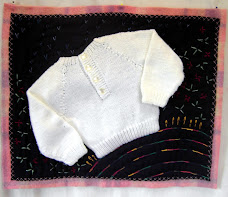Cowra Art Group: 0ur interpretation of a "wagga"
Image : Chris Hatton and the Cowra Art Group "wagga" (Gwen Clark photographer)
 Within the Cowra Art Group there are several talented and creative groups. There is a craft group, and also a group of quilters. Some months ago a few of us were fortunate to meet with the WRAP ladies while they were in Cowra planning this exhibition.
Within the Cowra Art Group there are several talented and creative groups. There is a craft group, and also a group of quilters. Some months ago a few of us were fortunate to meet with the WRAP ladies while they were in Cowra planning this exhibition.We went back to our groups inspired to make our own wagga. We gathered magazine articles and dredged up some childhood memories deciding to make our wagga of the Depression era. We soon abandoned that idea as being too impractical, deciding on this traditional one. The quilters brought their sewing machines, scissors, ironing board and fabric ... designing and making the blocks which are approx 35cm square, sewing them into strips then joining the strips together.
Most of the fabric is wool. There are three layers ending in a tweed backing.
One lady had some buttons (from her mother-in-law) left over from Broadway Tailors in Sydney. The craft ladies used these buttons and knots to "tie" the fabric layers together.
Some of our ladies have been members of the Art Group for a long time … some are over 80 and even over 90. One has a walking frame, another a walking stick, some have sight issues and some now live in Bilyara - Cowra's retirement village, but they still come to Tuesday's craft day.
Everyone sewed on buttons ...even if needles had to be threaded and hands guided.
The quilters then bound the quilt .. four of them finished off the hand sewing.
One lady from Bilyara was on holidays and her friend was concerned she would be disappointed she had missed out... as soon as Joan was back she sewed on her button.
Our aim was 1. Make a quilt in the tradition of the ‘wagga’, and 2. Create a quilt that the ladies in the groups could look at and say "I did some of that".
Hopefully we have achieved this and I know everyone was delighted to see it hanging in the Cowra Art Gallery with the impressive work from the WRAP Group. From Jenny Mason President Cowra Art Group
Extracts from stories from some of our members about "waggas"
1. We watched and helped our grandmother, who was a tailoress, make "waggas'. She would keep left over material and any old clothes such as tunics and trousers with material still usable. We would then spend afternoons cutting and placing pieces together in the size of the beds, laid out on her huge kitchen table. These were then sewn on the old treadle sewing machine, or blanket stitched together, then filled and lined. Sometimes flour bags old curtains or summer materials were used.
Every Christmas holidays our Pop who worked as a grader driver for Waugoola Shire Council and camped away in a caravan all week would bring his van home. We loved helping our grandmother clean it out renew the curtains and make a new wagga......... Sisters Judy and Robin
2. When I was growing up the lady next door had a cupboard on the back verandah where she kept old scraps, cardigans and, of all things - old boned corsets. I was about nine and remember her taking the bones out. She was making a wagga and somehow stitched it in with other pieces of all shapes and sizes. One side was covered with bleached flour bags and on the top in the place of honour was a piece of cretonne. It was as heavy as lead ..... Pam
3. My husband remembers stockmen and rabbiters working on the property had waggas made from wool sacks …… Jo
4. On the sleepout at my mother-in-law's farms at Cudal and Korawatha the black iron beds had patchwork quilts of various types of furs backed by felt. When we started talking about ‘waggas’, I thought these must have been a variation of a wagga……. Lola
5. One old shearer always came with his ‘swag’ wrapped in a kangaroo skin, and would proudly roll out his swag on the iron shearer’s hut bed where it would stay until he moved on to another shed.
Old wheat bags, too thin to hold grain anymore, were unstitched and joined together as blankets and also hung as outside walls for the boys ‘bedrooms’ on the verandah, (allowing the cat to add his warmth to the bed at night). Nothing fancy for the boys. The wheat bags were also used as make-shift but very effective raincoats, or protection for the shoulders when ‘lumping’ bags of wheat …… Nev



1 comment:
that's a lovely collection of stories you have there...and some beautiful waggas. i'm putting a link to your page from mine...
Post a Comment